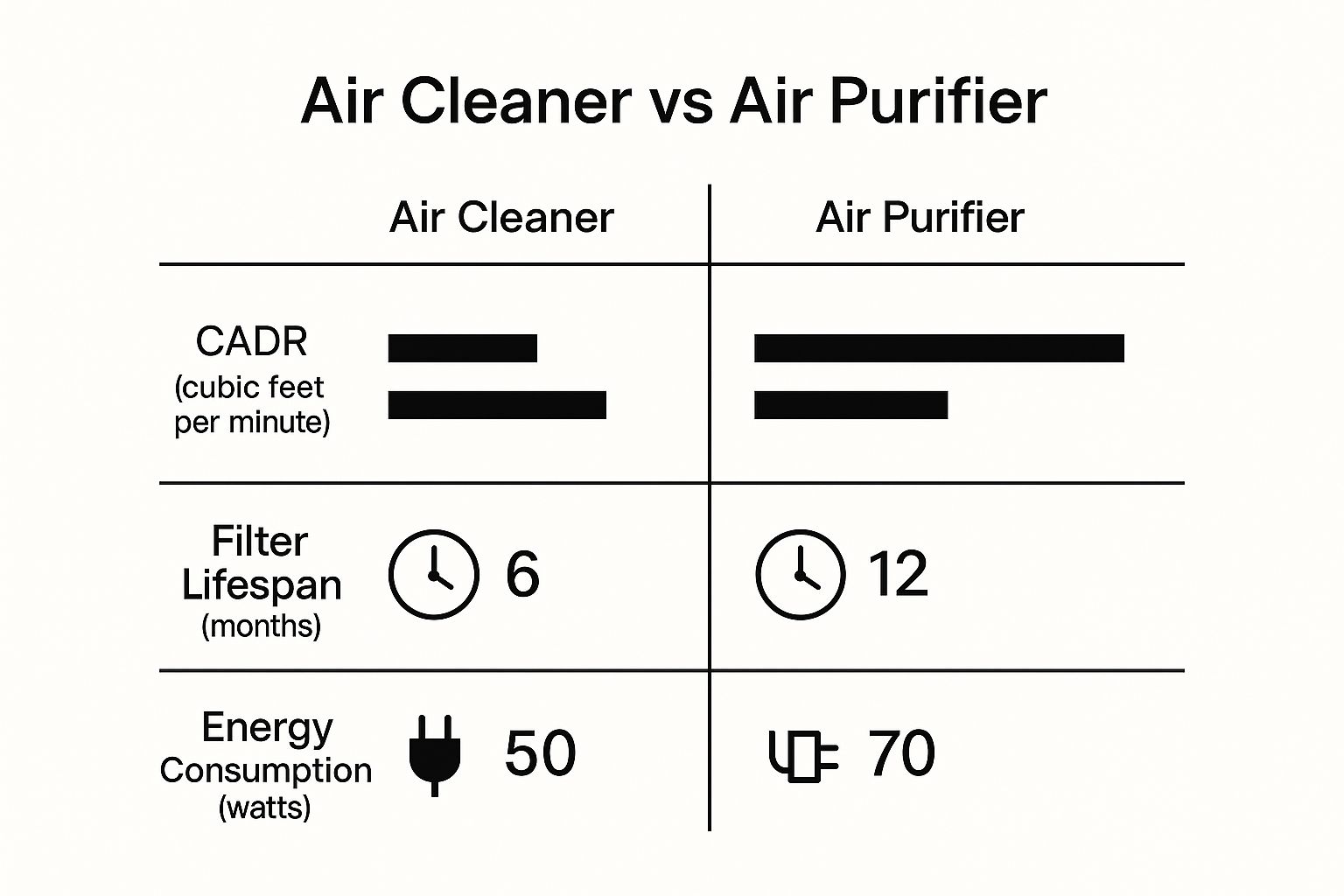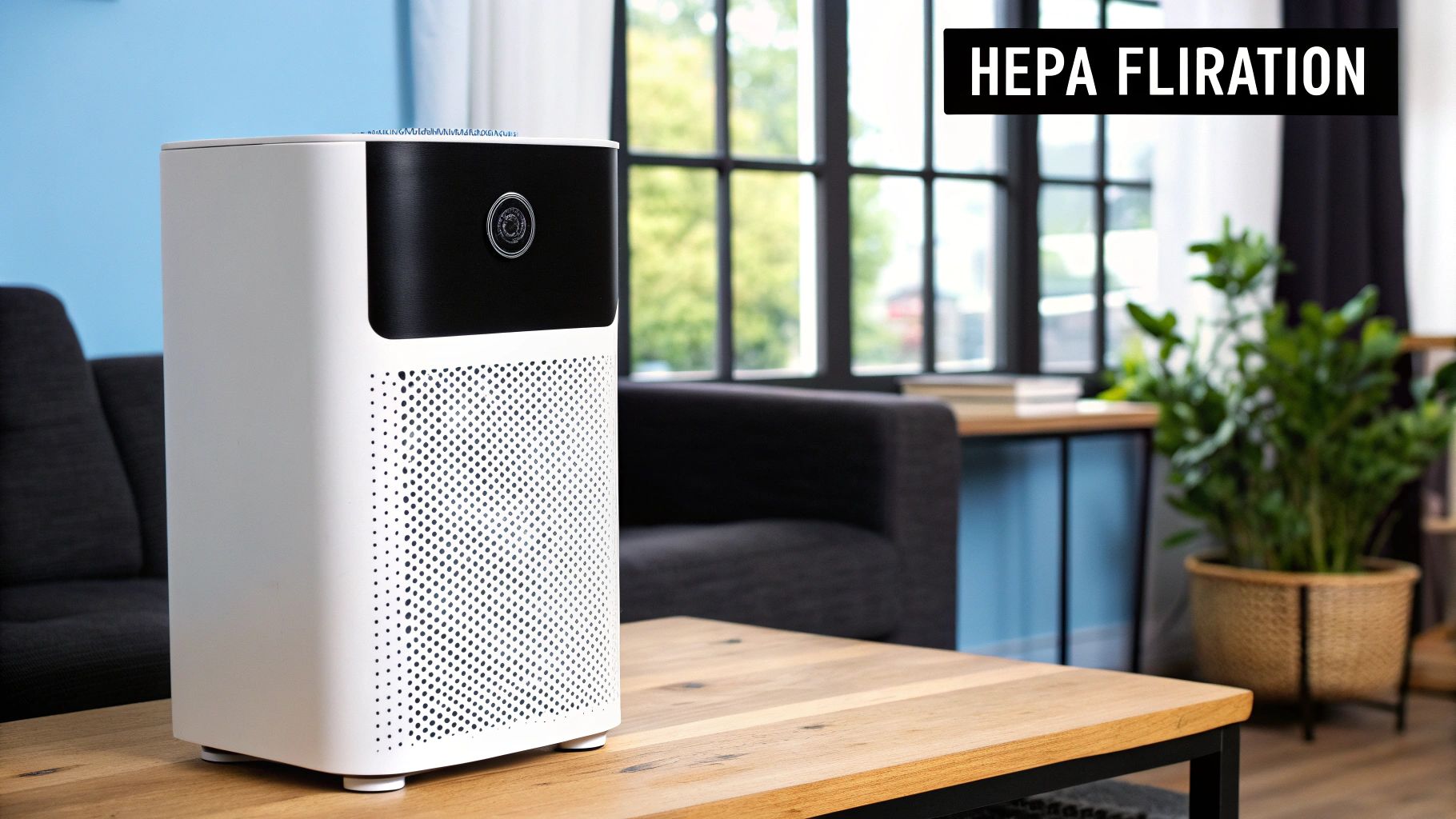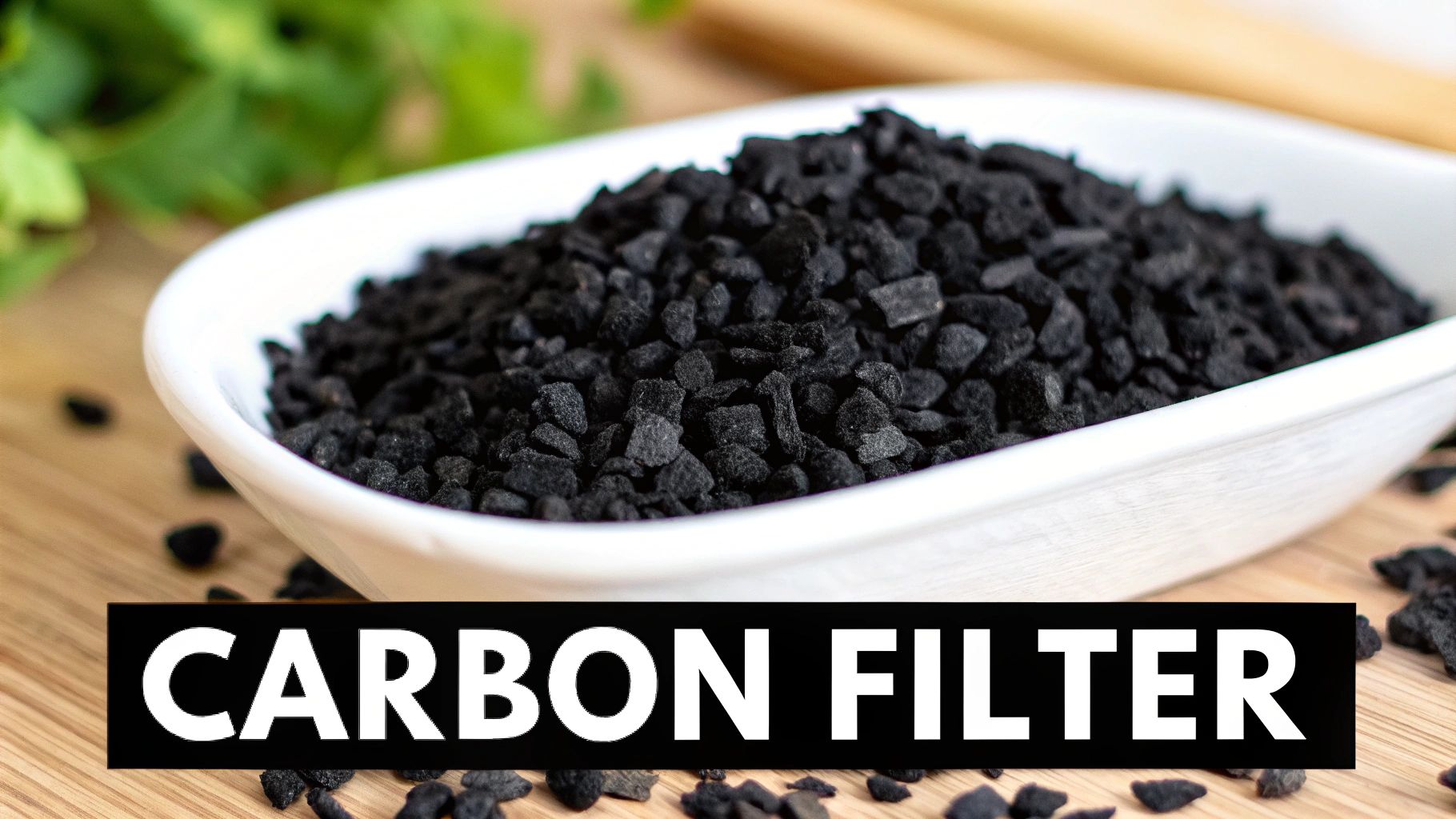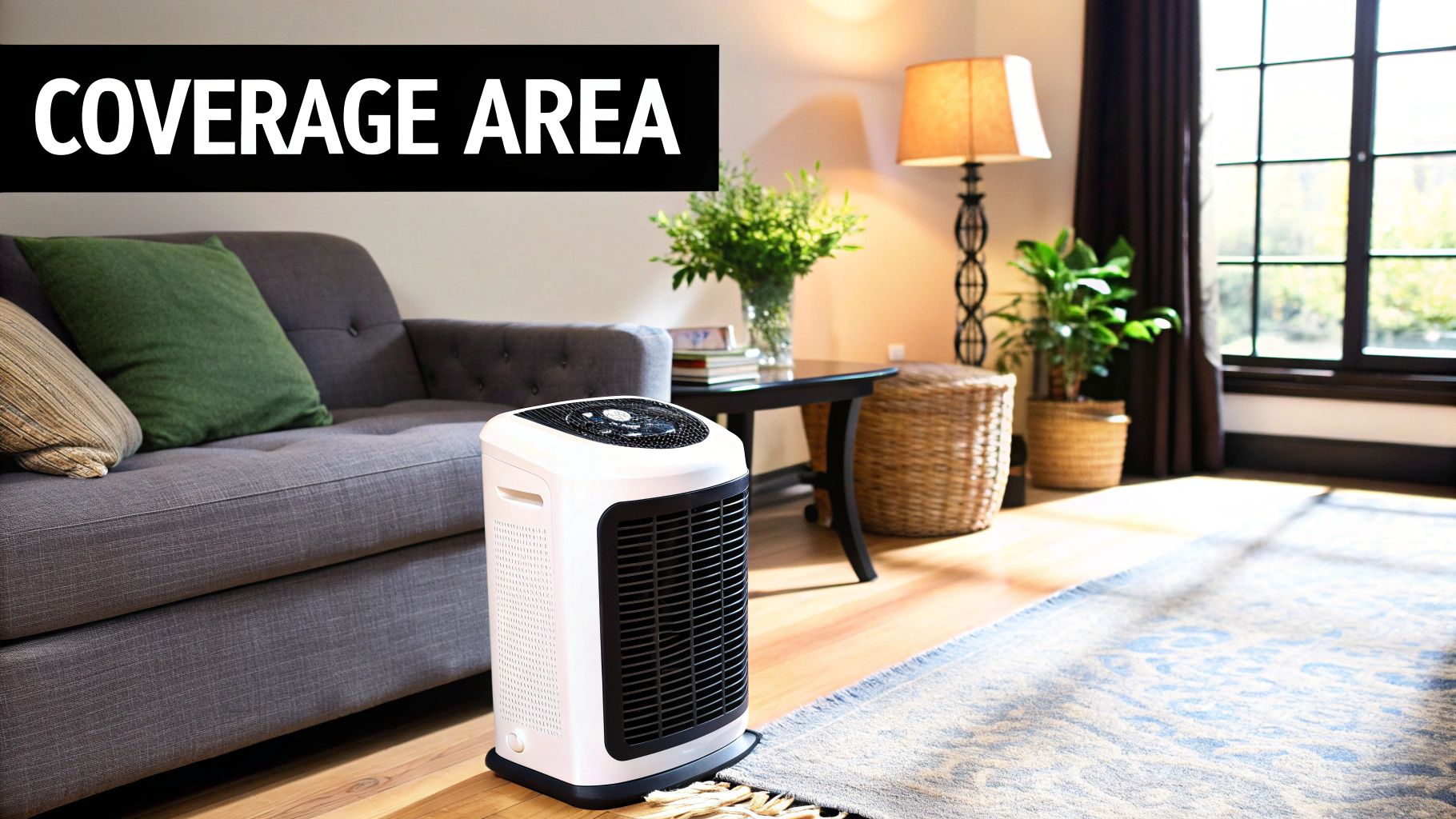Air Cleaner vs Air Purifier A Practical Guide
- shawnpurifiedair
- Jul 12
- 10 min read
At first glance, "air cleaner" and "air purifier" seem like two names for the same thing. While marketing teams often use them interchangeably, there's a real, functional difference under the hood that matters for your home's air quality.
The simplest way to think about it is this: an air cleaner *traps* physical particles, while an air purifier *neutralizes* or treats them. An air cleaner is like a high-tech net, excellent at catching things like dust, pollen, and pet dander. A purifier, on the other hand, does that and adds another layer of technology to handle invisible threats like germs, gases, and odors.
What Is the Real Difference Between an Air Cleaner and a Purifier?
Let's dig into the technology. An air cleaner is fundamentally a mechanical device. It works by pulling air through a physical filter—usually a HEPA filter—to physically capture airborne contaminants. This makes it a fantastic tool for dealing with common allergens like dust, pet dander, pollen, and even mold spores.
An air purifier typically starts with that same filtration but builds on it with active technologies to treat the air. These can include:
Activated Carbon: This material is incredibly porous and great at absorbing odors, chemical fumes, and volatile organic compounds (VOCs) that a simple HEPA filter can't touch.
UV-C Light: This is the germ-fighting component. UV light is used to scramble the DNA of airborne viruses, bacteria, and mold, effectively neutralizing them so they can't reproduce.
Ionization: These systems release charged ions into the air. The ions attach to pollutants, making them clump together and become heavier, which makes them much easier for the filter to capture or for them to fall out of the air.
This distinction is more important than ever. With the global air purifier market expected to hit USD 4.45 billion by 2029, it's clear people are looking for solutions that do more than just filter out dust. If you're interested in these advanced systems, you can learn more about them in our guide on what an ActivePure air purifier is.
Core Function Quick Comparison
To make it even clearer, here’s a quick breakdown of how these two types of devices stack up based on their primary jobs. Think of this as the "at-a-glance" guide to their core strengths.
Feature | Air Cleaner (Particle Focus) | Air Purifier (Holistic Treatment) |
|---|---|---|
Primary Goal | Traps physical particles (dust, pollen) | Traps particles, neutralizes germs, absorbs odors |
Key Technology | HEPA Filter | HEPA Filter + UV-C, Activated Carbon, Ionizer |
Best For | Allergies, dust, pet dander | Germs, viruses, odors, VOCs, smoke |
Ultimately, an air cleaner is your go-to for allergies, while a purifier offers a more comprehensive treatment for a wider range of air quality issues.
This visual helps illustrate how performance metrics like CADR (Clean Air Delivery Rate), filter lifespan, and energy consumption can differ between the two.

As you can see, while their core performance can look similar, the added technologies in a purifier can affect things like maintenance needs and energy use. It's all about finding the right balance for what you need to tackle in your home's air.
How Filtration and Purification Technologies Work

The gold standard here is the HEPA (High-Efficiency Particulate Air) filter. Just imagine it as an incredibly fine, tangled web of fibers. When air flows through this web, bigger particles like dust, pet dander, pollen, and some bacteria simply can't get through and get stuck. A true HEPA filter is certified to capture a staggering 99.97% of particles as tiny as 0.3 microns.
While this physical filtration is the foundation, a true air purifier doesn't stop there. It adds more advanced layers to the process.
Advanced Purification Methods
Air purifiers take that foundational particle-trapping and build on it, adding technologies that can neutralize or destroy the pollutants that physical filters miss. This is where you get a much more complete treatment of your indoor air.
Activated Carbon Filters: This is your best defense against smells and gases. Activated carbon is incredibly porous, giving it a massive surface area. Those tiny pores act like sponges, absorbing gas molecules from things like cooking fumes, smoke, and volatile organic compounds (VOCs), effectively yanking them out of the air.
UV-C Light: Think of this as the germicidal layer. Ultraviolet-C (UV-C) light is a powerful disinfectant. As air passes the UV-C bulb, the light scrambles the DNA and RNA of microorganisms like viruses, mold spores, and bacteria, making it impossible for them to reproduce and cause illness.
Ionizers: These components work by sending out charged ions (anions) that latch onto pollutants floating in the air. This makes the particles heavier, causing them to either fall to the ground or clump together, which makes them a much bigger and easier target for the HEPA filter to catch on the next cycle.
Key Takeaway: A HEPA filter is fantastic for trapping physical particles you can't see. But it's the other technologies, like activated carbon and UV-C light, that tackle the truly invisible threats like gases, odors, and germs.
It’s this combination of different technologies that allows an air purifier to do more than just manage allergens. It’s designed to attack a much wider range of contaminants to make the air you breathe genuinely healthier.
Decoding Performance Metrics for Your Room Size

CADR is a standardized score that tells you how quickly a unit can supply clean, filtered air to a room. It's measured in cubic feet per minute for three common pollutants: tobacco smoke, dust, and pollen. A simple rule of thumb I've always found useful is to match the CADR to your room's square footage. The smoke CADR should be at least two-thirds of your room's area. So, for a 300-square-foot living room, you'd want a unit with a smoke CADR of at least 200 to ensure it has enough muscle to make a real difference.
Air Changes and Real-World Impact
Beyond just raw power, you need to think about how often the air in your room is actually getting cleaned. This is where Air Changes per Hour (ACH) comes in. It’s a measure of how many times the unit can completely filter all the air in a given room within a single hour.
For general freshness, a unit that provides 2-3 ACH is perfectly fine. But if you or someone in your family struggles with allergies or asthma, you'll want to aim higher. I always recommend shooting for 4-5 ACH in those cases; it provides much more significant relief from airborne triggers.
Crucial Insight: A high ACH rating isn't just a number, it's about speed. The faster a unit removes pollutants, the less time you're actually exposed to them. It’s the difference between slowly chipping away at contaminants and actively maintaining a clean, healthy breathing space.
Finally, think about what it will be like to live with the machine day in and day out. Check the decibel (dB) rating at various fan speeds to make sure it won't keep you up at night or disrupt your work-from-home calls. And don't forget to look for an Energy Star certified model. This is more than a sticker; it’s a guarantee of efficiency that will save you real money on your electricity bill over the years. These practical metrics help you find a device that’s not just powerful, but also quiet and economical.
Calculating the True Cost of Ownership
When you’re weighing an air cleaner against an air purifier, the sticker price is just the beginning of the story. A basic air cleaner might look like the more budget-friendly choice upfront, but the real cost reveals itself over the life of the machine. You have to look at the ongoing maintenance to get a true picture of your long-term financial commitment.
An air cleaner's main running cost is its HEPA filter, which you'll typically need to replace every 6 to 12 months. With an air purifier, however, the expenses start to stack up. You’ve still got the HEPA filter to think about, but you also need to budget for its other specialized components. For example, activated carbon filters, which are crucial for trapping odors and VOCs, usually get saturated and need swapping out every 3 to 6 months.
Breaking Down Long-Term Expenses
If your air purifier is equipped with a UV-C bulb to neutralize germs, that's another recurring cost. These bulbs typically have a lifespan of about 9,000 hours, roughly a year of non-stop use, and must be replaced to keep zapping germs effectively. This multi-layered maintenance is a huge difference between the two.
The total cost of ownership goes far beyond the initial purchase. It's the sum of the unit's price plus the cumulative cost of all filter and bulb replacements over several years of operation.
This financial reality is becoming more important as people get serious about their air quality. The global air purifier market was valued at around USD 16.9 billion and is projected to hit USD 30.1 billion by 2033, a trend fueled by growing health awareness. You can find more details on this growth in market reports like those on GrandViewResearch.com. As technology advances, understanding these hidden costs is key to making a smart, sustainable investment in your home.
To make this crystal clear, let's map out what these costs might look like over a five-year period.
Below is a table that breaks down the estimated expenses for both types of devices, helping you see beyond the initial price tag.
Estimated Five Year Cost Breakdown
Cost Factor | Typical Air Cleaner | Advanced Air Purifier |
|---|---|---|
Initial Price | $100 - $300 | $250 - $700 |
HEPA Filters (5 Yrs) | $150 - $400 | $200 - $500 |
Carbon Filters (5 Yrs) | N/A | $100 - $300 |
UV-C Bulbs (5 Yrs) | N/A | $75 - $200 |
Total 5-Year Cost | $250 - $700 | $625 - $1,700 |
As you can see, the long-term investment for an advanced air purifier can easily be double or even triple that of a simpler air cleaner. This makes it essential to match the device's capabilities—and its associated costs—to your specific air quality needs.
Choosing the Right Device for Your Specific Needs

Alright, let's move past the technical jargon. The real question is, how do these specs translate into a solution for your home? The best device is the one that directly tackles your main air quality problem without you paying for features you simply don't need.
For many people, the fight is physical. If you're constantly battling allergies and your biggest enemies are dust, pollen, and pet dander, a quality air cleaner with a True HEPA filter is your best bet. It’s a straightforward, cost-effective tool that excels at trapping those common irritants.
But what if your concerns are more complex? An air purifier is the clear winner when you need to go beyond just particles. It's the right choice for city dwellers dealing with traffic fumes, homes with smokers, or anyone trying to get rid of chemical smells (VOCs) from new paint or furniture.
Matching Technology to Your Lifestyle
To make it even clearer, let's walk through a few common household scenarios. It all comes down to matching the machine to the specific contaminants you want gone.
For a Nursery or Child's Room: This is where an advanced air purifier really shines. You get the HEPA filter for dust and dander, plus the added protection of UV-C light to neutralize airborne germs, creating a stronger shield for delicate immune systems.
For a Home Office: New desk? New carpet? Those items can release VOCs into the air. An air purifier with a good-sized activated carbon filter is essential here to absorb these chemicals and make your workspace healthier.
For a Household with Smokers: A basic air cleaner just won't cut it. To handle the persistent odors and gases from smoke, you absolutely need an air purifier with a substantial activated carbon filter.
Situational Recommendation: Don't overspend. An air cleaner is perfect for particle-driven allergies. But if you’re dealing with gases, germs, or smoke, the extra technologies in an air purifier are what will actually clean your air.
This demand for specific, targeted solutions is why the portable air purifier market is booming, with projections showing it will hit $31.21 billion by 2033, according to StraitsResearch.com. More and more, people are looking for convenient ways to address health concerns like asthma. And if you're thinking bigger than just one room, you might find our homeowner's guide to in-duct air cleaners helpful.
Answering Common Questions About Air Cleaners and Purifiers
To make sure you feel totally confident in your choice, let's tackle some of the most common questions that pop up when you're deciding between an air cleaner and an air purifier. These are the practical, real-world concerns that go beyond a basic air cleaner vs air purifier spec sheet.
Will a Basic Air Cleaner Help with Smells?
Honestly, not really. If you're counting on a standard air cleaner with just a HEPA filter to get rid of odors, you'll likely be disappointed. While it's great at trapping physical particles like dust and dander—some of which might carry smells—it can’t do anything about the actual gases and volatile organic compounds (VOCs) that cause them.
For stubborn smells from pets, cooking, or chemicals, you need an air purifier equipped with an activated carbon filter. That's the component specifically designed to absorb those gaseous pollutants and truly neutralize odors.
Do Ionizers in Air Purifiers Create Harmful Ozone?
This is a great question and a very valid concern. It's true that some older or lower-quality ionizers can produce ozone as a byproduct, and ozone is a known lung irritant you definitely don't want in your home.
However, most modern, reputable air purifiers are built to produce virtually no ozone. The gold standard here is to look for models certified by the California Air Resources Board (CARB). It's illegal to sell any air cleaner in California that generates unsafe ozone levels, so this certification is a strong indicator of safety.
Expert Tip: I always tell my clients to check for CARB certification on any purifier that uses ionization. It's the simplest way to get peace of mind knowing the device has been rigorously tested and is safe for your family.
How Many Hours a Day Should I Run My Device?
For the best results, you should run your air cleaner or purifier 24 hours a day. I know that might sound like a lot, but airborne pollutants are constantly being introduced into your home from cooking, cleaning, pets, and even just opening a door.
If you only run the device intermittently, you're always just playing catch-up. Thankfully, most modern units are quite energy-efficient, especially those with an Energy Star rating, so the impact on your electricity bill is usually minimal.
Can One Unit Work for My Whole House?
A single portable air cleaner or purifier is almost always designed for a single room. Its power is measured by its Clean Air Delivery Rate (CADR), which is specifically matched to a certain square footage. Sticking a small unit in a large, open-concept living area just won't be effective.
For a true whole-home solution, you have two main options: buy multiple portable units for key rooms or, for a more seamless approach, install an in-duct system that works with your home's HVAC. To get a better sense of how to manage air quality everywhere in your home, take a look at our [guide to improving indoor air quality](https://www.purifiedairductcleaning.com/post/aguidetoimprovingindoorairquality).
Ready to breathe easier with a professional, whole-home solution? The experts at Purified Air Duct Cleaning specialize in installing advanced ActivePure® systems that go beyond simple filtration. Contact us today for a free quote and discover how we can improve the air quality in every room of your Arizona home.

